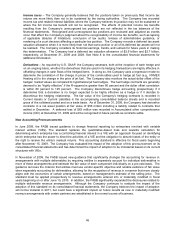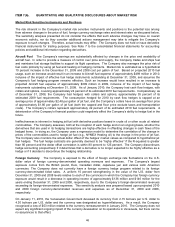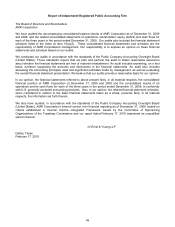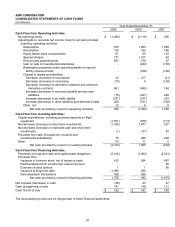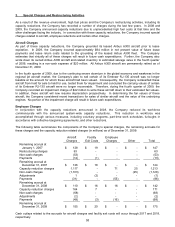American Airlines 2009 Annual Report Download - page 58
Download and view the complete annual report
Please find page 58 of the 2009 American Airlines annual report below. You can navigate through the pages in the report by either clicking on the pages listed below, or by using the keyword search tool below to find specific information within the annual report.
55
NOTES TO CONSOLIDATED FINANCIAL STATEMENTS
1. Summary of Accounting Policies
Basis of Presentation The accompanying consolidated financial statements as of December 31, 2009 and for
the three years ended December 31, 2009 include the accounts of AMR Corporation (AMR or the Company) and
its wholly owned subsidiaries, including (i) its principal subsidiary American Airlines, Inc. (American) and (ii) its
regional airline subsidiary, AMR Eagle Holding Corporation and its primary subsidiaries, American Eagle Airlines,
Inc. and Executive Airlines, Inc. (collectively, AMR Eagle). The consolidated financial statements as of and for the
years ended December 31, 2009, 2008 and 2007 include the accounts of the Company and its wholly owned
subsidiaries as well as VIEs for which the Company is the primary beneficiary. All significant intercompany
transactions have been eliminated.
New Accounting Pronouncements In accordance with U.S. GAAP, the Company has adopted new fair value
measurements guidance as it applies to non-financial assets and liabilities, including the Company’s routes. U.S.
GAAP defines fair value, establishes a framework for measuring fair value and enhances disclosures about fair
value measurements. Fair value is defined as the exchange price that would be received for an asset or paid to
transfer a liability (an exit price) in the principal or most advantageous market for the asset or liability in an orderly
transaction between market participants on the measurement date. The guidance was applied in the fourth
quarter of 2009, in conjunction with the Company’s annual impairment testing on routes, at which time the net
carrying value of the routes was reassessed for recoverability. It was determined through this annual impairment
testing that the fair value of certain routes was less than the carrying value, and the Company adjusted the value
of these route assets to their respective fair values. See Note 11 to the consolidated financial statements for
more information regarding the route impairment and supplementary disclosure as required under the standard.
The Company adopted new accounting guidance related to its accounting for convertible debt instruments as of
January 1, 2009. The adoption impacted the historical accounting certain senior convertible notes that were
retired as of December 31, 2009. The Company filed a Current Report on Form 8-K on April 21, 2009 to reflect
the retrospective adoption of the new accounting guidance on the 2008, 2007 and 2006 financial statements.
In December 2008, the Financial Accounting Standards Board (FASB) issued new guidance requiring additional
disclosures about assets held in an employer’s defined benefit pension or other postretirement plan, primarily
related to categories and fair value measurements of plan assets. The Company has adopted the new standard
effective December 31, 2009. The only impact to the Company was to require additional disclosures related to
the Company’s pension assets. See Note 10 to the consolidated financial statements for the required disclosure.
In June 2009, the FASB issued guidance to change financial reporting by enterprises involved with VIEs. The
standard replaces the quantitative-based risks and rewards calculation for determining which enterprise has a
controlling financial interest in a VIE with an approach focused on identifying which enterprise has the power to
direct the activities of a VIE and the obligation to absorb losses of the entity or the right to receive the entity’s
residual returns. This accounting standard is effective for fiscal years beginning after November 15, 2009. The
Company has evaluated the impact of the adoption of this pronouncement on its consolidated financial statements
and has determined the impact of adoption to be immaterial.
In November of 2009, the FASB issued new guidance that significantly changes the accounting for revenue in
arrangements with multiple deliverables by requiring entities to separately account for individual deliverables in
more of these arrangements. The guidance removes the criterion that entities must use vendor-specific objective
and reliable evidence of fair value when separately accounting for deliverables, allowing for the recognition of
revenue in a manner that more closely aligns with the economics of certain arrangements based on
management’s estimate of the selling price. The standard must be applied prospectively to revenue
arrangements entered into or materially modified in fiscal years beginning on or after June 15, 2010. In addition,
the FASB significantly expanded the disclosures related to multiple deliverable revenue arrangements. Although
the Company continues to evaluate the impact of the adoption of this standard on its consolidated financial
statements, the Company believes the impact of adoption will not be material in 2011, but could have a significant
impact on future results as new or materially modified revenue arrangements with certain partners are established
in the normal course of business.
Use of Estimates The preparation of financial statements in conformity with U.S. GAAP requires management
to make estimates and assumptions that affect the amounts reported in the accompanying consolidated financial
statements and accompanying notes. Actual results could differ from those estimates.


